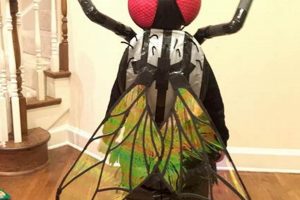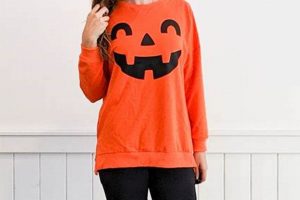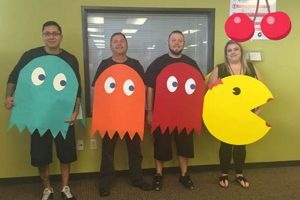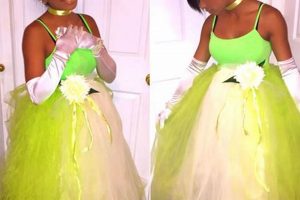A homemade skeletal attire, typically crafted for celebratory occasions such as Halloween, involves the construction of a garment that simulates the appearance of a human or animal skeleton. This can range from simple designs using black clothing and white paint to more elaborate constructions employing materials like cardboard, felt, and specialized adhesives to create three-dimensional bone structures. The creation of this attire offers an opportunity for individual expression and resourcefulness.
The appeal of producing this type of outfit stems from its potential for cost-effectiveness, personalization, and creative exploration. Purchasing pre-made costumes can be expensive, and the availability of unique designs is often limited. Constructing the attire allows for modification based on individual preferences and body size, ensuring a comfortable and distinctive look. Historically, homemade costumes have been a staple of holiday celebrations, reflecting a tradition of ingenuity and community involvement.
The following sections will delve into various approaches for constructing a skeletal representation, detailing material selection, application techniques, and considerations for safety and durability. These methods offer practical guidance for individuals seeking to create their own unique version of this iconic attire.
Creating a Skeleton Costume
Constructing a convincing skeletal representation requires careful planning and execution. These tips provide a framework for achieving a successful outcome.
Tip 1: Garment Selection: Opt for a dark-colored, form-fitting base layer. Black leggings and a long-sleeved shirt provide an ideal canvas for applying skeletal details. The snug fit ensures the bones appear anatomically correct.
Tip 2: Material Choice: White fabric paint is a versatile medium for rendering bone shapes. Consider using acrylic paint for durability and washability. Alternatively, felt or foam sheets can be cut into bone shapes and affixed to the garment with fabric glue.
Tip 3: Anatomical Accuracy: Consult anatomical diagrams to ensure the bone placements are realistic. Pay attention to the relative sizes and shapes of different bones, such as the ribs, vertebrae, and long bones of the limbs.
Tip 4: Stencil Application: Utilize stencils for precise bone delineation. These can be commercially purchased or created at home using cardstock or acetate sheets. Stencils guarantee consistent and recognizable bone shapes.
Tip 5: Highlighting and Shading: Introduce subtle shading to create depth and dimension. Light gray paint or charcoal can be used to accentuate the curves and contours of the bones, enhancing their three-dimensional appearance.
Tip 6: Durability Considerations: Securely attach any embellishments to withstand movement and activity. Fabric glue should be allowed to fully cure before wearing the attire. Reinforce seams and edges to prevent detachment.
Tip 7: Safety Precautions: Ensure any paints or adhesives used are non-toxic and safe for skin contact. Avoid using small, detachable parts that could pose a choking hazard, particularly for children.
Adhering to these guidelines promotes the creation of a visually appealing and durable skeletal representation. Attention to detail and safety is paramount.
The subsequent sections will address advanced techniques and alternative approaches for crafting a more elaborate and customized skeletal costume.
1. Anatomical Accuracy
Anatomical accuracy serves as a critical determinant in the effectiveness of a skeletal attire. The degree to which a constructed skeletal representation mirrors the actual human or animal skeletal structure directly influences its visual impact and perceived realism. A meticulously crafted outfit, faithful to anatomical principles, enhances the overall aesthetic and communicates a higher level of craftsmanship.
- Bone Proportion and Scale
Correctly representing the relative size and proportions of individual bones is fundamental. For instance, the femur should be noticeably longer than the tibia, and the cranium’s size should be in proportion to the torso. Deviations from these proportions undermine the realism and create a cartoonish or inaccurate representation.
- Skeletal Arrangement and Articulation
The accurate arrangement of bones and their articulation points is essential. Ribs should correctly attach to the spine, and the joints of the limbs should align properly. Failure to adhere to these structural principles can result in a disjointed or unnatural appearance.
- Detailing and Surface Features
Inclusion of surface details, such as the curvature of ribs, the shape of the scapula, and the subtle contours of the skull, elevates the realism of the attire. These details, while often subtle, contribute significantly to the overall impression of anatomical fidelity.
- Symmetry and Bilateral Representation
Maintaining bilateral symmetry is crucial for creating a balanced and realistic skeletal representation. Corresponding bones on either side of the body should mirror each other, accounting for minor variations that exist in natural skeletal structures.
The integration of anatomical accuracy within the creation of skeletal attire significantly enhances the visual impact and realism of the costume. By focusing on bone proportion, arrangement, detailing, and symmetry, the final product transcends simple representation and achieves a higher level of artistry and believability. This rigorous approach elevates the costume from a mere visual effect to a representation grounded in scientific accuracy, increasing its potential for impact and engagement.
2. Material Selection
The selection of appropriate materials is paramount to the successful creation of skeletal attire. The chosen materials directly influence the costume’s visual impact, durability, comfort, and safety. Inappropriate material selection can result in a costume that is uncomfortable to wear, prone to damage, or aesthetically unconvincing. Conversely, thoughtful material choices enhance the costume’s overall effect and longevity.
For instance, using lightweight, breathable fabrics as a base layer ensures wearer comfort, particularly during extended periods of wear. The application of skeletal details might involve paints, adhesive fabrics, or three-dimensional elements. The choice of paint should consider its adherence to the base fabric, its resistance to cracking or fading, and its potential for skin irritation. Adhesive fabrics, such as felt or foam, offer an alternative approach to rendering bone shapes but require careful consideration of their durability and attachment method. Three-dimensional elements, such as molded plastic bones or foam
structures, introduce a more realistic appearance but necessitate secure attachment and consideration of potential hazards, such as sharp edges or small parts. A real-world example involves using glow-in-the-dark paint on a black bodysuit, enhancing visibility in low-light conditions; however, the paints durability and washability must be assessed beforehand to ensure the costume remains effective after repeated use.
In conclusion, material selection represents a critical step in crafting skeletal attire. Prioritizing comfort, durability, visual appeal, and safety necessitates a thorough understanding of material properties and their suitability for the intended application. The informed choice of materials directly translates into a costume that is both visually striking and practically viable, contributing significantly to the overall success of the endeavor.
3. Application technique
The application technique employed in constructing skeletal attire dictates the precision, clarity, and overall aesthetic quality of the final representation. This technique encompasses the specific methods used to transfer the skeletal design onto the chosen garment or material and significantly influences the realism and impact of the costume.
- Stenciling
Stenciling involves the use of pre-cut templates to apply paint or other materials in precise patterns. This technique allows for consistent and repeatable bone shapes, reducing the risk of freehand errors. For example, a stencil of a ribcage ensures uniform rib spacing and curvature, contributing to a more anatomically accurate representation. Inconsistent pressure or paint bleed under the stencil can, however, diminish the effect.
- Freehand Painting
Freehand painting offers greater creative freedom and allows for nuanced detailing. This technique is suitable for adding subtle shading and highlights to individual bones, enhancing their three-dimensional appearance. However, freehand painting requires a high degree of artistic skill and anatomical knowledge. An example is creating the subtle contours of the skull or adding detail to the vertebrae. Mistakes in freehand painting can lead to inaccuracies and inconsistencies in the overall design.
- Adhesive Application
Adhesive application involves attaching pre-cut bone shapes made from materials such as felt or foam to the base garment using fabric glue or other adhesives. This technique allows for the creation of raised, three-dimensional bone structures. The success of this method depends on the strength and durability of the adhesive, as well as the precise placement of the bone shapes. Incorrect adhesive application or poorly cut shapes can result in a visually unappealing or unstable costume.
- Airbrushing
Airbrushing provides a versatile technique for creating gradients and subtle shading effects on the skeletal attire. This method allows for the seamless blending of colors, resulting in a realistic and professional-looking finish. The use of an airbrush requires specialized equipment and a degree of skill to control the paint flow and achieve the desired effect. An example might be creating shadows around the ribcage to simulate depth. Inexperience with airbrushing can lead to uneven coverage or overspray.
The selection of an appropriate application technique is crucial for achieving a visually compelling skeletal attire. The technique should be chosen based on the desired level of detail, the available skills and resources, and the overall aesthetic goal. Each technique offers distinct advantages and disadvantages, and the successful application of any method requires careful planning and execution. For instance, combining stenciling for the main bone structure with freehand painting for details can offer a balance between precision and artistic expression. Proper application ensures the skeletal attire accurately and effectively conveys the intended visual message.
4. Durability considerations
Durability represents a significant factor in the creation of a homemade skeletal attire. The longevity and sustained visual impact of the costume directly correlate with the materials and construction techniques employed. Prioritizing durability mitigates the risk of damage during wear and handling, extending the lifespan of the garment and ensuring its suitability for multiple uses.
- Fabric Selection and Reinforcement
The choice of base fabric dictates the costume’s resilience to tearing and stretching. Selecting a tightly woven, durable material such as canvas or denim, as opposed to a thin, loosely woven fabric, provides a more robust foundation. Reinforcing stress points, such as seams and areas where embellishments are attached, with additional stitching or durable adhesives further enhances the garment’s structural integrity. For example, reinforcing the shoulder seams on a skeletal shirt prevents tearing under the weight of attached bone appliques.
- Paint and Adhesive Stability
The long-term adherence of paints and adhesives is crucial for maintaining the visual integrity of the skeletal design. Selecting paints formulated for fabric application and employing appropriate surface preparation techniques ensure optimal adhesion. Similarly, using fabric-specific adhesives and allowing sufficient curing time prevents detachment of embellishments during movement. The failure to select weather resistant paints in a diy skeleton costume will cause paint fade, wash away, and possible cause the material to peel off after several wear.
- Attachment Security
The method of attaching skeletal elements, such as bone appliques or three-dimensional structures, significantly impacts the costume’s overall durability. Securely sewing appliques onto the base fabric or using industrial-strength adhesives minimizes the risk of detachment during wear. For three-dimensional elements, incorporating internal support structures or reinforcing attachment points distributes stress and prevents breakage. Insecurely attached elements can lead to visual degradation and potential safety hazards.
- Washability and Maintenance
Considering the costume’s washability influences its long-term maintainability. Selecting materials and application techniques that withstand laundering cycles, or opting for spot cleaning methods, prevents damage and discoloration. The durability can improve the design. For example, testing the colorfastness of paints before applying them to the entire garment ensures the design remains vibrant after washing. Neglecting washability considerations can lead to premature wear and degradation of the costume’s visual appeal.
Integrating durability considerations into the design and construction of skeletal attire enhances its longevity and value. By prioritizing fabric selection, adhesive stability, attachment security, and washability, individuals can create a costume that withstands repeated use and maintains its visual impact over time. These considerations directly translate into a more sustainable and cost-effective approach to crafting skeletal representations.
5. Safety compliance
The creation of homemade skeletal attire mandates adherence to safety standards to mitigate potential hazards. Direct contact between skin and certain materials used in costume construction can trigger adverse reactions, underscoring the importance of material selection. Specifically, paints, adhesives, and fabrics should be non-toxic and hypoallergenic. The improper use of sharp tools during construction, such as scissors or craft knives, poses a risk of injury. Adequate workspace and careful handling are essential preventive measures. A real-life example involves the use of glitter, commonly employed for decorative effect, which can detach and pose a choking hazard to young children. Similarly, small, detachable parts used to simulate skeletal features also present a choking risk, necessitating careful design and secure attachment methods.
The flammability of costume materials represents another critical safety consideration. Costumes constructed from highly flammable fabrics, such as certain synthetic materials, pose a significant fire hazard, particularly in environments with open flames or heat sources. Selecting flame-retardant materials or applying flame-retardant treatments to costume components reduces this risk. Illumination elements, such as LED lights integrated into the costume, require careful attention to power sources and wiring to prevent electrical hazards. Batteries should be securely enclosed, and wiring should be insulated to prevent short circuits or overheating. The absence of proper ventilation in enclosed costume components can lead to overheating and discomfort, underscoring the need for breathable designs.
In summary, safety compliance is an integral component of crafting skeletal attire. Selecting non-toxic materials, employing safe construction techniques, mitigating flammability risks, and addressing potential choking hazards are essential for ensuring the well-being of the wearer. Prioritizing safety considerations not only minimizes the risk of injury but also enhances the overall enjoyment and sustainability of the costume. The application of appropriate safety measures transforms the creation of a skeletal representation from a potentially hazardous activity into a creative and secure endeavor.
Frequently Asked Questions
This section addresses common inquiries regarding the creation of homemade skeletal attire, providing concise and authoritative answers to facilitate informed decision-making throughout the construction process.
Question 1: What base garment is most suitable for creating a skeletal representation?
A dark-colored, form-fitting garment, such as black leggings and a long-sleeved shirt, provides an ideal canvas. The close fit ensures accurate bone placement and prevents fabric bunching.
Question 2: Which materials are recommended for rendering bone details on a costume?
White fabric paint, acrylic paint, felt, and foam sheets are commonly used. Fabric paint and acrylic offer durability and washability, while felt and foam allow for three-dimensional bone construction.
Question 3: How can anatomical accuracy be ensured when creating skeletal attire?
Consult anatomical diagrams to guide bone placement and proportion. Pay close attention to the relative sizes and shapes of individual bones and their articulation points.
Question 4: What techniques are effective for applying bone details to a garment?
Stenciling provides precision and consistency, while freehand painting allows for nuanced detailing and shading. Adhesive application is suitable for attaching pre-cut bone shapes made from felt or foam.
Question 5: How can the durability of a skeletal costume be enhanced?
Select durable fabrics, reinforce seams and attachment points, and use paints and adhesives that are resistant to cracking and detachment. Consider the costume’s washability during material selection.
Question 6: What safety precautions should be observed when crafting skeletal attire?
Use non-toxic materials, avoid small, detachable parts that pose a choking hazard, and ensure adequate ventilation. If using lights, follow safety standards to avoid electrical hazards.
Creating a successful skeletal costume necessitates attention to detail, material selection, and adherence to safety guidelines. Prioritizing these factors ensures a visually appealing and durable result.
The subsequent sections will delve into advanced customization techniques for those seeking to elevate their creations.
DIY Skeleton Costume
The foregoing analysis has underscored the multifaceted nature of creating skeletal attire. It is evident that producing a compelling “diy skeleton costume” extends beyond mere mimicry. The successful execution of such a project necessitates a deliberate approach, encompassing anatomical fidelity, meticulous material selection, skillful application techniques, stringent durability considerations, and unwavering safety compliance. Each element contributes integrally to the final product’s visual impact, longevity, and overall suitability.
The meticulous crafting of skeletal attire, therefore, serves as a testament to individual creativity and technical proficiency. The principles outlined herein offer a comprehensive framework for constructing a visually striking and structurally sound representation. Continued innovation and refinement in both materials and techniques will undoubtedly shape the future of “diy skeleton costume” design, offering ever-greater opportunities for artistic expression and sartorial ingenuity. The pursuit of excellence in this domain ultimately elevates the craft from a simple exercise in costume creation to a profound engagement with art, anatomy, and engineering principles.







